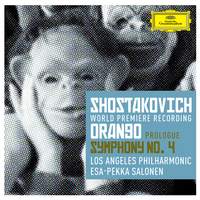Recording of the Week,
New Shostakovich discovery - Orango
A newly discovered Shostakovich opera? Well, not quite – the 1932 score of Orango was commissioned by the Bolshoi to mark the fifteenth anniversary of the October Revolution, but only developed as far as a thirty-minute Prologue before unspecified political machinations nipped it in the bud. It’s such a fascinating score that it’s impossible not to reflect on What Might Have Been, but what we do have is well worth investigating, both in terms of historical significance and on its own terms as music-theatre.

The manuscript of Orango (just thirteen pages of piano-score) was discovered in Moscow’s Glinka Museum in 2004 by Olga Digonskaya, and after extensive consultations with Shostakovich’s widow Irina the draft was orchestrated by Gerard McBurney and premiered by the Los Angeles Philharmonic and Esa-Pekka Salonen last December in a concert-staging by Peter Sellars. (The recording is taken from these live performances.) The Prologue introduces us to the title-character, the result of a mad scientist’s attempt to cross-breed apes and humans, as he is paraded before the crowds at a State pageant: after introductions by a spin-doctor-cum-Master-of-Ceremonies and from his creator, Orango dances wearily to their tune for a while before snapping and ravaging a foreign woman in the audience. Once the ensuing chaos dies down, the MC proposes to stage Orango’s life-story for the entertainment of the crowd... Here the Prologue and Shostakovich’s score ends, so Orango’s protracted adventures as a trench-soldier in the Great War, a Parisian wide-boy and a capitalist press-baron never came to fruition.
Dramatically, there are echoes and anticipations of other twentieth-century operas – the circus-like atmosphere and creepy MC prefigure Berg’s Lulu, premiered just five years later, and the surreal picaresque narrative which was to have followed recalls Janacek fantastical Excursions of Mr Broucek – but the music is unmistakeably Shostakovich. There are brash, militaristic marches, apparently hearty workers’ choruses, manic dance-episodes and deliberately saccharine ballet-interludes; the influence of jazz and film-music is rarely far away (Shostakovich was working on the score during a particularly prolific period in cinema-work, and in fact recycled material from The Bolt in this score).
Though the precise circumstances surrounding the abandonment of the project are shrouded in mystery, it’s pretty obvious why it came to such an abrupt halt: the premise is too controversial, the satire simply too overtly biting to have won favour with the authorities. The performer is reduced to a dancing monkey; the glittering, mechanical and sedative nature of state-approved art is represented by the ballerina Nastya, who is commanded to dance in order to subdue the rampaging ape; the pervasive atmosphere is one of rebellion only just held in check. All told, it’s hard to imagine that Orango would have gone down well – after all, just five years later Lady Macbeth of the Mtsensk District (which Shostakovich was completing as he worked on Orango) would be attacked as ‘Muddle Instead of Music’ in Pravda, and it’s surely very likely that Orango would have met with a similar denunciation.
American baritone Ryan McKinny makes an oleaginous, sinister Master of Ceremonies, whilst the rather thankless title-role is taken by Eugene Brancoveanu: his role in the Prologue gives him little to work with other than a series of groans, yawns and the odd inarticulate phrase, but even with these limited resources he manages to convey the ape’s dangerous pent-up strength and almost Calibanesque poetic sensibility.
Though the curiosity-value of Orango is perhaps the main draw of the set, it’s also worth having for the coruscating account of the Fourth Symphony (another work which was withdrawn by the terrified composer – unlike Orango, it was actually completed but only received its premiere almost three decades later) which made up the second half of the programme in Los Angeles. As a testimony to the composer’s self-censorship, there’s a chilling beauty to this set which I shan’t forget in a hurry, and Orango is a find in a thousand.
Los Angeles Philharmonic, Esa-Pekka Salonen
Available Formats: MP3, FLAC



